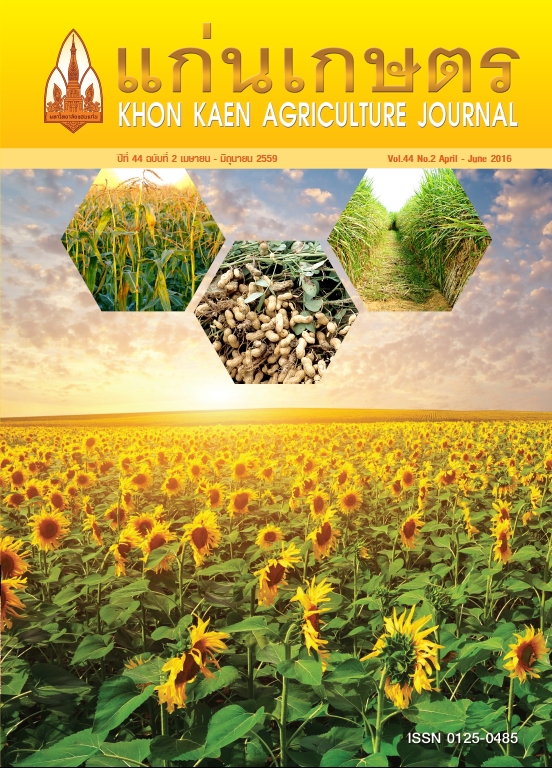การประเมินความสัมพันธ์ทางพันธุกรรมของฟักทองไทย 29 สายพันธุ์ด้วยเครื่องหมายดีเอ็นเอ AFLP
Main Article Content
บทคัดย่อ
ฟักทองพันธุ์การค้าของไทยมีจำนวนมากแต่ลักษณะทางสัณฐานวิทยาของฟักทองเหล่านั้นมีลักษณะใกล้เคียงกันทั้งทรงผล สีผล ลักษณะผิว ซึ่งมาจากความต้องการของผู้บริโภค ดังนั้นจึงทำการศึกษาความสัมพันธ์ทางพันธุกรรมของฟักทองพันธุ์การค้าของไทย และพันธุ์พื้นเมืองบางพันธุ์ ประกอบด้วยฟักทอง 29 พันธุ์ (พันธุ์ผสมเปิด 5 พันธุ์ พันธุ์ลูกผสม 20 พันธุ์) และพันธุ์พื้นเมือง 4 พันธุ์ เพื่อใช้เป็นข้อมูลในการปรับปรุงพันธุ์ต่อไป โดยใช้เทคนิค AFLP (Amplified Fragment Length Polymorphisms) จากไพรเมอร์จำนวน 28 คู่ไพรเมอร์ พบว่ามีเพียง 7 คู่ไพรเมอร์ ที่พบความแตกต่างของแถบดีเอ็นเอโดยมีทั้งหมด 168 แถบ วิเคราะห์ค่าสัมประสิทธิ์ความเหมือน Dice Similarity coefficient และจัดกลุ่มด้วยวิธี UPGMA (Unweighted pair group method with arithmetic average) พบว่ามีค่าความเหมือนระหว่าง 0.21-0.96 ที่ค่าดัชนีความเหมือนเฉลี่ย 0.81 สามารถจัดกลุ่มฟักทองได้ 2 กลุ่ม กลุ่มที่ 1 ประกอบด้วยฟักทองจำนวน 23 พันธุ์ ซึ่งเป็นฟักทองพันธุ์การค้าและพันธุ์พื้นเมืองบางพันธุ์ กลุ่มที่ 2 ประกอบด้วยฟักทองเพียง 2 พันธุ์ และมี 4 พันธุ์ที่ไม่สามารถจัดกลุ่มได้ และเมื่อจัดกลุ่มด้วยวิธี Neighbor-joining method บนพื้นฐานของ Nei’s (1972) Standard genetic distance (Ds) สามารถจัดฟักทองได้ 3 กลุ่ม และมี 6 พันธุ์ที่ไม่สามารถจัดกลุ่มได้ จากการศึกษาครั้งนี้ ทำให้ทราบว่าฟักทองพันธุ์การค้าของไทยในปัจจุบันมีความใกล้เคียงกันทางพันธุรรมสูง และสามารถคัดเลือกฟักทองได้ 5 พันธุ์ ที่มีความห่างทางพันธุกรรมกับฟักทองส่วนใหญ่ คือ พันธุ์ Tung K-Tone KPS-1 CM-1 และ EP เพื่อใช้สำหรับเป็นพ่อแม่พันธุ์ในการปรับปรุงพันธุ์และสร้างความหลากหลายทางพันธุกรรมของฟักทองไทยต่อไป
Article Details
เอกสารอ้างอิง
ปณาลี ภู่วรกุลชัย, สราวุฒิ เกตุแก้ว, เขมวรรณ ศรีตงกิม, บุบผา คงสมัย และอัญมณี อาวุชานนท์. 2555. การศึกษาความสัมพันธ์ทางพันธุกรรมด้วยเครื่องหมายดีเอ็นเอ SRAP และลักษณะคุณภาพผลของฟักทองพันธุ์การค้าของไทยบางพันธุ์. การประชุมวิชาการแห่งชาติ มหาวิทยาลัยเกษตรศาสตร์ วิทยาเขตกำแพงแสน ครั้งที่ 9. 1100-1106.
Agawal, G.K., R.N. Pandey, and V.P. Agawal. 1992. Isolation of DNA from Cheorospondias asillaris leaves. Biotech Biodiv Lett. 2: 19-24.
AVRDC. 2007. Available: http://goo.gl/Vp6e7A. Accessed Jan. 15, 2012.
Creste, S., D.M. Sansoli, A.C.S. Tardiani, D.N. Silva, F.K. Goncalves, T.M. Favero, C.N.F. Medeiros, C.S. Festucci, L.A. Carlini-Garcia, M.G.A. Landell, and L.R. Pinto. 2010. Comparison of AFLP, TRAP and SSRs in the estimation of genetic relationships in sugarcane. Sugar Tech. 12(2): 150-154.
Du X.Y., Q.L. Zhang, and Z.R. Luo. 2009. Comparison of four molecular markers for genetic analysis in Diospyros L. (Ebenaceae). Plant Syst. 281: 171-181.
Ferriol, M., B. Pico, and F. Nuez. 2003. Genetic diversity of a germplasm collection of Cucurbita pepo using SRAP and AFLP markers. Theor Appl Genet. 107: 271-282.
Ferriol, M., B. Picó, P.F. Córdova, and F. Nuez, 2004. Molecular diversity of a germplasm collection of squash (Cucurbita moschata) determined by SRAP and AFLP markers. Crop Sci. 44: 653-664.
Garcia, J., M. Oliver, and H. Gomez-Paniagua. 2000. Comparing AFLP, RAPD and RFLP markers for measuring genetic diversity in melon. Theor Appl Genet. 101: 860-864. germplasm using the AFLP technique. Hort. Sci. 38(1): 81-84.
Gwanama, C., M.T. Labuschagne, and A.M. Botha. 2000. Analysis of genetic variation in Cucurbita moschata by random amplified polymorphic DNA (RAPD) markers. Euphytica. 113: 19-24
Hurtada, M.A., A. Westman, E. Beck, G.A. Abbott, G. Llacer, and M.L. Badenes. 2002. Genetic diversity in apricot cultivars based on AFLP markers. Euphytica. 127: 297-301.
Levi, A., C.E. Thomas, T. Trebitsh, A. Salman, J. King, J. Karalius, M. Newman, O.U.K Reddy, Y. Xu, and X. Zhang. 2006. An extended linkage map for watermelon based on SRAP, AFLP, SSR, ISSR and RAPD markers. J. Amer. Soc. Hort. Sci. 131(3): 393-402.
WebMD. 2015. Vitamins and Supplements Lifestyle Guide. Available: http://goo.gl/yW6LZg. Accessed May. 12, 2015.
Nei, M. 1972. Genetic distance between populations. Amer. Nat. 106: 283-291.
Nei, M., and W.H. Li. 1979. Mathematical models for studying genetic variation in term of restriction endonucleases. Proc. Natl. Acad. Sci. 76: 5268-5273.
Nei, M., and W.H. Li. 1979. Mathematical models for studying genetic variation in term of restriction endonucleases. Proc. Natl. Acad. Sci. 76: 5268-5273.
Saitou N., and M. Nei. 1987. The Neighbor-joining Method: A new method for reconstructing phylogenetic trees. Mol. Biol.Evol. 4(4): 406-425.
Tamura, K., M. Nei, and S. Kumar. 2004. Prospects for inferring very large phylogenies by using the neighbor-joining method. The National Academy of Sciences of the USA. 101: 11030-11035.
Teulat, B., C. Aldam, R. Trehin, J.H.A. Barker, G.M. Arnold, A. Karp, L. Baudouin, and F. Rognon. 2000. An analysis of genetic diversity in coconut (Cocos nucifera) populations from across the geographic range using sequence-tagged microsatellites (SSR) and AFLPs. Theor Appl Genet. 100: 764-771.
Thermo Fisher Scientific Inc. 2015. Selective amplification start-up kit for small plant genome, 50-500 Mbp. Available: https://goo.gl/5XaC3k. Accessed July. 4, 2015.
Vos, P., R. Hogers, M. Bleeker, M. Reijans, T. van de Lee, M. Hornes, A. Frijters, J. Pot, J. Peleman, M. Kuiper, and M. Zabeau. 1995. AFLP: a new technique for DNA Fingerprinting. Nucleic Acids Research. 23(21): 4407-4414.
Wu, J., Z. Chang, Q. Wu, H. Zhan, and S. Xie. 2011. Molecular diversity of Chinese Cucurbita moschatagermplasm collections detected by AFLP markers. Scientia Horticulturae. 128: 7-13.
Y. Xu, and X. Zhang. 2006. An extended linkage map for watermelon based on SRAP, AFLP, SSR, ISSR and RAPD markers. J. Amer. Soc. Hort. Sci. 131(3): 393-402
Zhang, D., J. Cervantes, Z. Huaman, E. Carey, and M. Ghislain. 2000. Assessing genetic diversity of sweet potato (Ipomoea batatas (L.) Lam.) cultivars from tropical America using AFLP. Genetic Resources and Crop Evolution. 47: 659-665.


